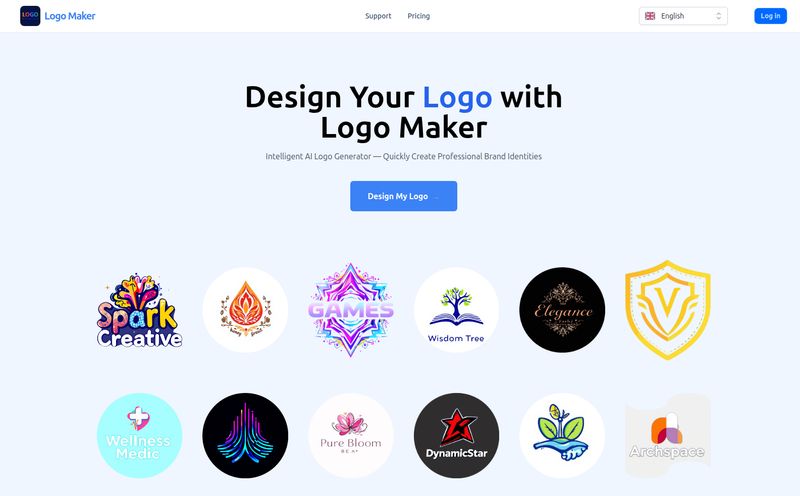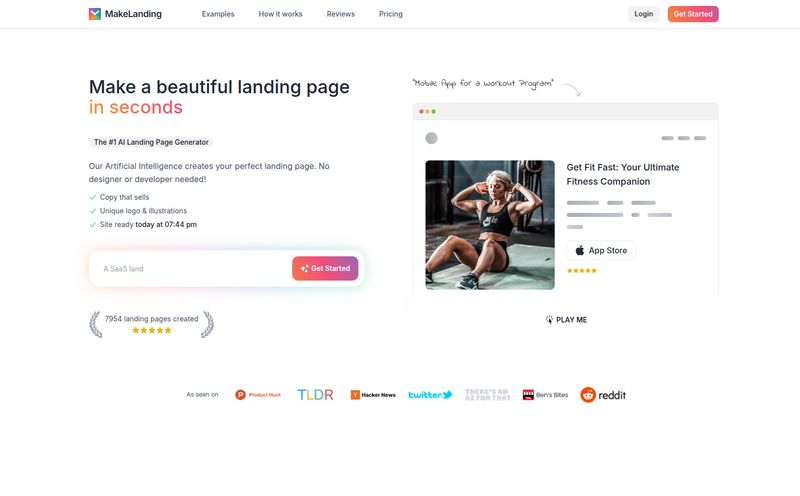You and me. As a fellow marketer, you know the grind. The endless cycle of briefing designers, tweaking copy, and pumping out dozens of banner variations for the week's promo. By the time you’re done, a new promo has already started. It’s a content hamster wheel, and for years, it’s been one of the most soul-crushing parts of running an e-commerce site.
I’ve lost count of the hours spent staring at a Photoshop file, trying to perfectly center a product image in a 728x90 leaderboard banner, knowing full well I had to do it all over again for a 300x250 medium rectangle. It's tedious. It's repetitive. And honestly? It’s not the best use of a creative human brain.
So, when I hear about a platform that promises to automate it all using AI, my ears perk up. But my skepticism meter also goes into overdrive. I’ve seen a lot of so-called “AI” tools that are just fancy template engines. That's why I decided to take a closer look at a tool called Product Hero. They claim to be an automated e-commerce banner generation platform. A big claim. Let's see if they can back it up.
What Exactly is Product Hero Anyway?
Okay, so on the surface, Product Hero creates banners for your website and email campaigns. Simple enough. But the magic isn't what it does, but how it does it. This isn't just a library of pre-made templates you plug your products into. That's been done. Been there, bought the T-shirt.
Instead, Product Hero hooks directly into your product feed and—this is the important part—your existing recommendation engine. Think of it less like a design tool and more like a smart, automated pipeline. It uses AI to analyze your product images, understand your brand’s style, and then generate personalized banners at scale. We're talking about banners that show the most relevant products to each specific visitor. It’s like having a junior designer who is also a data scientist, working 24/7, who never complains about last-minute changes. A dream, right?

Visit Product Hero
The Real Power of AI in Creative Automation
The term 'AI' gets thrown around so much it’s almost lost all meaning. In this case, though, it seems to have a specific job. Product Hero’s AI isn’t trying to be Picasso. Its goal is efficiency and relevance. It analyzes the composition of your product photos to figure out the best way to place them in a banner without awkward cropping. Ever had a model’s head cut off by an automated resizer? Yeah, this AI tries to prevent that.
But the real game-changer is the personalization. By integrating with recommendation engines (like Nosto or Dynamic Yield), the banners aren't just generic “Shop Our Sale!” messages. They can display products a user has previously viewed, items from an abandoned cart, or new arrivals that match their browsing history. This is the stuff that actually moves the needle on conversion rates and return on ad spend (ROAS). It's the difference between shouting into a crowd and having a quiet, persuasive conversation with an individual customer.
Key Features That Actually Matter to Marketers
Let's cut through the marketing fluff and look at the features that would make a difference in your day-to-day workflow.
True Automation Not Just Templates
The core promise here is set-it-and-forget-it. Once you’ve connected your product feed and set up your brand guidelines, Product Hero works in the background. New products get added to your store? The platform can automatically generate new banner assets for them. This is a massive time-saver, freeing up your team to focus on strategy instead of production.
Personalization That Goes Beyond "Hi [First Name]"
We’ve all seen basic personalization. This aims to go deeper. By showing dynamically updated product selections, you’re creating a more relevant and engaging user experience. A customer who has been browsing hiking boots should see banners featuring hiking boots, not summer dresses. It sounds obvious, but executing it across hundreds of banners manually is a nightmare. This is where automation becomes not just helpful, but necessary.
Keeping the Brand Police Happy
One of my biggest fears with automation tools is losing brand consistency. Nothing screams “we used a cheap tool” like off-brand fonts and colors. Product Hero seems to understand this. You can customize the designs to align with your brand guidelines—fonts, color palettes, logo placement, call-to-action button styles. The goal is for the automated banners to look indistinguishable from ones your in-house team would have painstakingly created.
Responsive Design Without the Headaches
Creating a campaign and then having to manually resize every single banner for desktop, tablet, and mobile is a special kind of torture. Product Hero generates responsive banners that adapt to different screen sizes automatically. This ensures a consistent experience for users, no matter how they’re browsing your site.
The Good The Bad and The Realistic
No tool is perfect. Let's get real about the pros and cons. I’ve always believed in a healthy dose of skepticism.
On the plus side, the benefits are pretty clear. You save an enormous amount of time and resources. You get truly personalized content which almost always leads to better engagement and higher conversion rates. And you maintain brand consistency across all your automated creatives. For a team stretched thin, this is a huge win.
However, this isn't a magic wand. There are some reality checks. First, its effectiveness is completely dependent on the quality of your inputs. You’ve heard the saying “garbage in, garbage out,” right? If your product feed is a mess or your product photography is low-quality, the banners will reflect that. Also, it requires integration with a product recommendation engine to unlock its full potential. If you dont have one, that’s an extra step (and potential cost) you need to consider.
And yes, there will be some initial setup. You can't just flip a switch. You'll need to invest time upfront to connect your systems and define your brand styles. But the idea is that this initial investment pays off tenfold in the long run.
So How Much Does This Magic Cost?
Ah, the million-dollar question. I did what any good researcher would do: I clicked the 'Pricing' link on their website. And I was greeted with... a "404 Not Found" error. Specifically, a `NoSuchKey` error from an Amazon S3 bucket. Ha! You gotta love it. It's a very real-world reminder that even tech companies have off days.
So, I can't give you a neat little pricing table. But based on my experience with similar SaaS platforms in the martech space, I can make an educated guess. Pricing is likely not a simple flat fee. It's probably a tiered subscription model based on factors like website traffic, the number of banner impressions served, or the number of products in your catalog. For tools this powerful, you're usually looking at a custom quote after a demo. So, your best bet is to hit that "Request a Demo" button and have a chat with their team.
Who is Product Hero Actually For?
Is this tool for everyone? Probably not. If you’re running a small Etsy shop with 15 handmade items, this is likely overkill. You'd be better off with a tool like Canva.
But if you are a medium to large-scale e-commerce business with hundreds or thousands of SKUs, this could be a game-changer. It's built for marketing teams who are bogged down by creative production and want to scale their personalization efforts. If you're already investing in a recommendation engine and want to get more value out of it, Product Hero could be the missing piece of the puzzle.
Final Thoughts: Is It a Hero or a Zero?
So what's the verdict? I'm cautiously optimistic. Product Hero isn't trying to reinvent the wheel; it's trying to build a better, faster car to put that wheel on. The concept of automating the most tedious part of e-commerce promotions while simultaneously making them more effective is, frankly, the holy grail for many online retailers.
It's not a plug-and-play solution for absolute beginners, and it requires a solid foundation (good product data) to work well. But for established e-commerce stores looking to scale, it presents a compelling value proposition. It’s a tool that promises to give you back your most valuable asset: time. And in the fast-paced world of online retail, that might just make it a hero after all.
Frequently Asked Questions about Product Hero
- Do I need to be a designer to use Product Hero?
- Not at all. That's kind of the whole point! It’s designed for marketers. You set up the brand guidelines (colors, fonts, etc.) during the initial setup, and the AI handles the layout and composition from there.
- What e-commerce platforms does it integrate with?
- While their site doesn't list them all, tools like this typically integrate with major platforms like Shopify, Magento, BigCommerce, and WooCommerce via plugins or API connections.
- Is the AI just picking a random layout for the banners?
- No. The AI analyzes the product image itself to find the focal point and whitespace, then arranges the elements (like product, price, and CTA) in a visually appealing way that's optimized for the specific banner size.
- How exactly does it improve conversion rates?
- The primary driver for conversion lifts is hyper-personalization. By showing users products they are genuinely interested in (based on their browsing data), the banners become highly relevant. A relevant ad is a helpful ad, and that leads to more clicks and sales.
- What if my product images aren't great quality?
- This is a critical point. The platform relies on your existing product assets. If you have low-resolution, poorly lit, or cluttered product photos, the automated banners will also look low-quality. For best results, you need a clean, high-quality product image library.
- Does it work for email marketing too?
- Yes, the platform is designed to generate banners for both on-site placement and for use in your email marketing campaigns, allowing you to carry that personalization over to your customers' inboxes.



